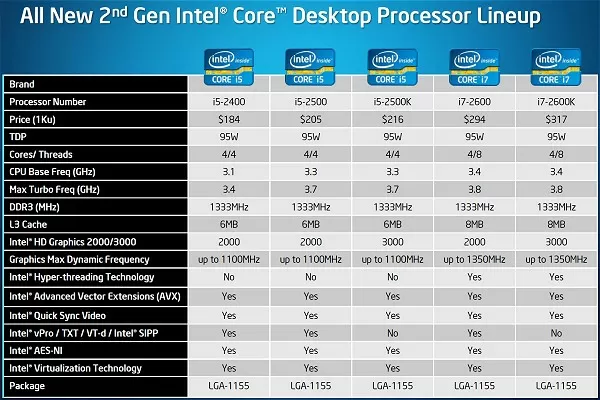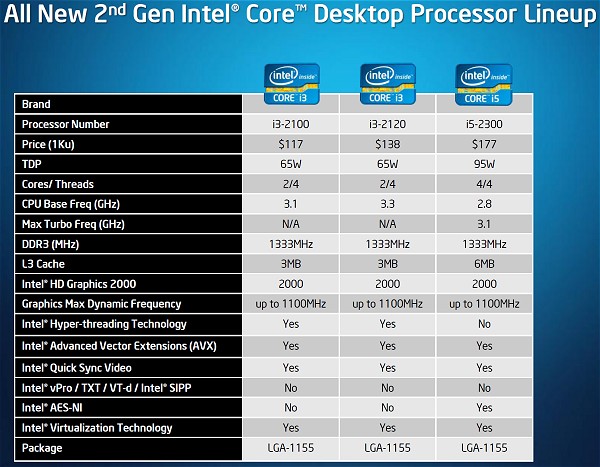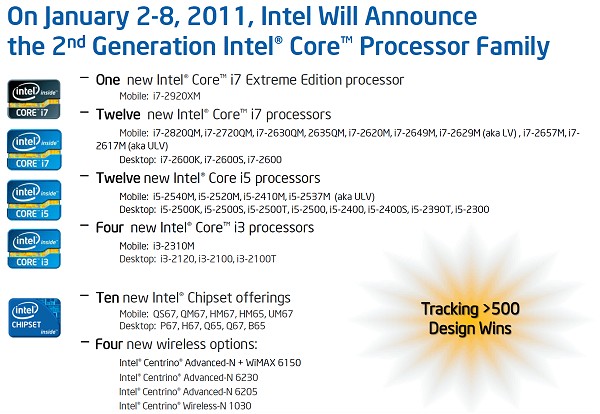2nd Gen Intel Core Lineup
The Sandy Bridge lineup is comprised of several desktop and mobile Core i7, Core i5 and Core i3 processors that will effectively replace most of the current offerings under those series. An additional ultra budget series based on similar technology is also expected to be released at some point this year.
The Core i7 desktop processors include the Core i7 2600K ($317), i7 2600S ($306) and i7 2600 ($294). The Core i7 2600K and i7 2600 are identical in almost every way with the exception of the unlocked multiplier of the K model and the absence of Intel vPro/TXT/VT-d/SIPP technology, also in the K model. The Core i7 2600S is a member of the low power series and as such the TDP has been reduced from 95w down to 65w.
A key factor in achieving this lower consumption is a lower CPU base frequency, which is reduced from 3.40GHz to just 2.80GHz. Furthermore, while the Core i7 2600K uses the Intel HD Graphics 3000 engine, the i7 2600 and 2600S models are downgraded to the HD Graphics 2000 engine.

All Sandy Bridge Core i7 processors feature 4 cores with 8 concurrent threads when using Hyper-Threading. The Core i7 2600K and i7 2600 operate at 3.40GHz with a Turbo Boost frequency of 3.80GHz (we'll discuss the new Turbo Boost 2.0 later on in the review). They are designed to work with DDR3-1333 memory and feature an 8MB L3 cache.
Then there is the new Core i5 series which features the i5 2300 ($177), i5 2400 ($184), i5 2500 ($205) and i5 2500K ($216) processors. There are also the Core i5 2390T, i5 2400S and i5 2500T low power models, we know, it gets very confusing, so let's talk about the standard processors first.
All standard Sandy Bridge Core i5 processors carry a 95W TDP and feature four cores and four concurrent threads, Hyper-Threading support is not available. The only Core i5 processor to differ from this configuration is the i5 2390T which features two cores with Hyper-Threading for four threads.
The Core i5 range is clocked quite aggressively: the i5 2300 operates at 2.80GHz with a Turbo Boost frequency of 3.10GHz. The i5 2400 operates at 3.10GHz with a Turbo Boost speed of 3.40GHz, and the i5 2500/i5 2500K processors operate at 3.30GHz and can reach as high as 3.70GHz when using Turbo Boost. All Core i5 processors feature a 6MB L3 cache with the exception of the i5 2390T which has been downgraded to 3MB.

All Core i5 processors use the Intel HD Graphics 2000 engine with the exception of the i5 2500K which uses the HD Graphics 3000 engine. Despite this, almost all Core i5 processors run the graphics processor at a maximum of 1100MHz, which is slightly less than that of the Core i7 processors.
The low power Core i5 range is even more confusing as the three models available at launch are all different and we have no pricing information for them yet. The Core i5 2390T is essentially a Core i3 processor with Turbo Boost added. This processor operates at 2.70GHz with a Turbo Boost speed of 3.50GHz. However like the Core i3 processors, the i5 2390T features only two cores with Hyper-Threading support and a smaller 3MB L3 cache.

Then there is the Core i5 2400S and i5 2500T. The i5 2400S features a thermal design rating of 65w and works at 2.5GHz with a Turbo Boost frequency of 3.30GHz. The i5 2500T on the other hand is actually slower, working at a base clock of 2.30GHz yet with the same Turbo Boost frequency of 3.30GHz. Moreover, the i5 2500T carries a 45w TDP and despite this it features the highest graphics processor frequency of any Core i5 processor at 1250MHz.
Finally we have the Core i3 2100 ($117) and i3 2120 ($138) processors which feature a TDP rating of 65w. There is also a low power version called the i3 2100T which features a TDP rating of just 35w with an operating frequency of 2.50GHz. The standard models operate much higher with the i3 2100 clocked at 3.10GHz and the i3 2120 at 3.30GHz. All feature a 3MB L3 cache and utilize the Intel HD Graphics 2000 engine which works at 1100MHz.